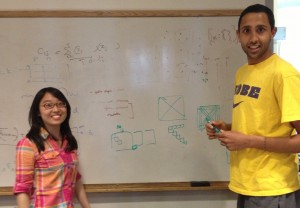Mobile Gaming Jam Captures Network Data
-
-
slice.mit.edu
Filed Under
Recommended

What did MIT students do last weekend? Some of them hosted a game jam.
Research students in the Computer Science and Artificial Intelligence Laboratory (CSAIL) Networks and Mobile Systems group extended an open invitation to local mobile game developers to come to the Stata Center and participate in a weekend-long challenge: create a game that encourages its players to go forth and explore new places.
The event resulted in a new mobile game made by a small group of developers; the team hopes to officially release it in the next two weeks. Game design teams who missed last weekend’s game jam can find the NetMap Game Client on Github.com should they wish to aid these researchers in their quest.
The hosts of the game jam have already been collecting data on their own about wireless and cellular networks via a tool called NetMap, as a class project for 6.829 Computer Networks. Three PhD students in the class–Tiffany Chen, Ravi Netravali, and Victor Costan ’07 MNG '08—believed that their research project could extend beyond just a class assignment. They wanted to collect more data to analyze from mobile users all over the world.
How could the team get users everywhere to find out about NetMap, install it, and provide more data for the researchers to analyze? Make a game, of course.
The Teaching Assistant of the students’ Computer Networks class, PhD student Jonathan Perry SM '12, took this idea one step further. He suggested the team host a game jam, a hackathon-like event for game developers to meet up and make a game in a single weekend.
“We needed an easy way to collect a large volume of measurements,” Perry explains. “If you’re going to go big-scale, why have one game when you can have many?”
Although the game jam event produced only one game so far, the team hopes for further development with NetMap in the future.
“Our wildest dream would be to have these collections everywhere where there are wireless device users,” says Netravali. “The problems of a poor connection can plague you anywhere.”
“You could find out if AT&T works better in this area or T-Mobile works better in this area,” Tiffany Chen explains. “You could know which service you should choose. Everybody can use that information.”
Perry hopes the data collected via NetMap and the team’s subsequent research and analysis will help network researchers. “When you make new network equipment or when you design new standards—later versions of 4G, for example or the next version of Wi-Fi—you can take into account data.”
The game jam focused on development for Android devices so that the games and the entire NetMap project can remain open source and freely available for future researchers and developers.


